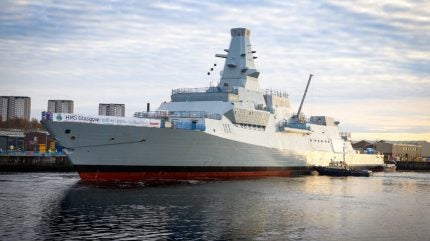
The UK’s Type 26 frigate design has been “down selected” by Norway for its future frigate platform, according to the UK government, with the Royal Norwegian Navy seeking options to replace the remaining four Fridtjof Nansen-class frigates with up to six new warships.
In a parliamentary written response on 9 December 2024, UK Defence Procurement Minister Maria Eagle stated the Ministry of Defence and the Department for Business and Trade were “actively supporting” the promotion of the Type 26 and Type 31 general purpose frigate “to other navies around the world” with similar requirements.

Discover B2B Marketing That Performs
Combine business intelligence and editorial excellence to reach engaged professionals across 36 leading media platforms.
“The Type 26 has been down selected as one of four options for the Norwegian Future Frigate competition,” Eagle stated.
The Type 26 design has already won export deals with its design to be used by Canada and Australia for their respective frigate programmes, with the UK Royal Navy expected to introduce eight City-class Type 26 frigates into service from 2028-2035 in a bid to reverse a steep decline in surface combatant numbers.
Norway wants to join existing production line
In mid-November, Norway’s Ministry of Defence announced that it had invited France, Germany, the UK, and US to “discussions on strategic partnership” for new frigates for the Royal Norwegian Navy.
“The new frigates represent the largest acquisition planned for the Norwegian Armed Forces in the coming years. Norway is an important maritime nation in Nato, and through this and other maritime investments we will be strengthening both national and allied security,” said Norwegian Minister of Defence, Bjørn Arild Gram.

US Tariffs are shifting - will you react or anticipate?
Don’t let policy changes catch you off guard. Stay proactive with real-time data and expert analysis.
By GlobalDataIn June 2024 the Norwegian Parliament passed the new Long-Term Plan for the Norwegian Armed Forces, which calls for the acquisition of a minimum of five, optionally six new anti-submarine warfare (ASW) frigates with embarked anti-submarine helicopters.

A Norwegian MoD release stated that the plan stressed that the new frigates are not to be procured as stand-alone vessels, but through a” long-term and mutually beneficial strategic partnership with a close ally” with strategic interests closely aligned with those of Norway.
The strategic partnership was to include “joint acquisition, operation, maintenance, continuous development and upgrades of the new frigates” throughout their service life.
In addition, to limit the need for upgrades of the Fridtjof Nansen-class, Norway is also looking to accelerate the acquisition by joining an existing production line for such vessels.
Norway’s future frigate: assessing the options
With the need to join an existing production line, and the ASW requirement, the options for Norway appear to be set, based on the countries it has invited for discussions.
Option 1: UK
For the UK, the Type 26 programme provides both an ASW-specific platform, a growing international supplier base in Australia and Canada, and an active production line, with the recent steel cutting for the fifth-in-class HMS Sheffield taking place at BAE Systems’ shipyard in Scotland.

Crucially, the Type 26 has been designed with a reduced acoustic signature and incorporates a combined diesel and gas (CODAG) turbine propulsion system, with integrated electric motors.
The other UK frigate currently under development, Babcock’s Type 31, also has an active production line but is not an ASW-specific design, instead being a general-purpose warship.
Option 2: France
France meanwhile can offer the FDI light frigate, currently in production for French and Greek navies, and described by Naval Group as being a multi-purpose platform able to conduct a full range of maritime and naval duties, including anti-submarine warfare.

The FDI design provides for more conventional combined diesel and diesel (CODAD) propulsion configuration. It is the smallest of the four possible options, displacing some 4,500 tonnes.
Option 2: Germany
Germany’s offering will likely be centred on its F126 frigate, of which six are planned to be introduced into the Germany Navy in replacement of the F123 Brandenburg-class frigates.
The F126 is the largest platform of the four potential designs being put forward for Norway at over 10,000 tonnes, offering a sizeable multi-purpose platform for naval operations.

Construction of the first-in-class F126 frigate Niedersachsen began in December 2023 and due to be delivered in December 2028. The design calls for the use of a combined diesel-electric and diesel propulsion configuration.
Option 4: US
Finally, the US, which abandoned naval frigates in favour of the development of the ill-fated twin-variant Littoral Combat Ship programme, is returning to the space with the introduction of the Constellation class, a heavily adapted variant of the European FREMM platforms.

However, design issues continue to plague the programme, which is seeing the concurrent conclusion of the platform design phase alongside the start of construction of the first-in-class USS Constellation.
The design is a combined diesel-electric and gas layout and intended to be a more multi-purpose frigate in keeping with the US Navy’s requirements. Along with the UK’s Type 26, the Constellation comes in between Germany’s F126 and France’s FDI, displacing around 7,500 tonnes.






